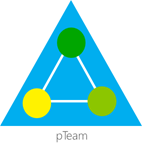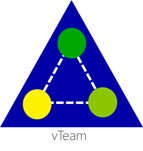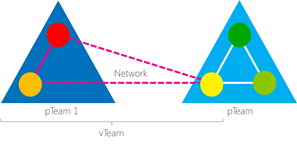World-Wide Virtual Teams from the ALM Rangers perspective (Part 1)
Our team has been discussing books and, more recently, articles focused on leadership. The latest article, Look Beyond the Team: It’s About the Network, by Jon R. Katzenbach, made me contemplate why we are reading and not writing these articles, as our team has a platter of real-world experience that we should be sharing with the ALM community.
The following table summarizes three common types of teams we have encountered over the past three decades:
DIAGRAM |
|||
OVERVIEW |
The oldest form is the physical team (pTeam), which has all team members collocated in the same physical area. |
The virtual team (vTeam) has team members dispersed across organizational and geographic boundaries. |
Today, the most common team is a hybrid version, which combines members of physicalteams into a virtual team, connected by a network. |
MAIN ADVANTAGE |
The ability to collaborate eye to eye, which is unfortunately still viewed as the best and often only way of management for successful teams. |
Recent innovations in collaboration and communication technology have allowed vTeams to collaborate effectively, enabling the sharing of best resources and regional experience, irrespective of physical location. |
With the hybrid model we are able to take advantage of both pTeams and vTeams. This model is used effectively within the developer division between Redmond and remote development centres, such as the Vancouver development centre. |
Table 1 - Common types of teams
The ALM Rangers have embraced an additional evolution of the virtual team, which we refer to as the worldwide virtual team, or wwvTeam. These teams are a geographically distributed, spanning many time zones and cultures. The team members are involved part-time, driven by passion not remuneration, committing their personal time and potentially compromising their home and work life balance. A Program Manager’s ultimate nightmare!
The concept of the wwvTeam is nothing new. Decades ago, we recognized the need to create virtual teams spanning geographic, organizational, cultural and expertise boundaries. When the ALM Rangers were formally established in 2006, we started the journey from the most basic level, to today’s wwvTeam and our customized process ”Ruck”, which, in the world of rugby, means “loose scrum.
What makes the wwvTeam work? The ALM Rangers operate with small teams, of less than 10 members. Based on recent observations, we’ve concluded that the ideal team size is 5 or fewer members,. Each team has at least one associated product owner. The product owner is not only the” face of the team” to both the leadership chain and the ALM Rangers community, but is the team member who makes the tough decisions about scope and engages other stakeholders as needed. Each team also has one project lead who enables, mentors and represents the team. Both these personas are part-time volunteers, like the rest of the team, which necessitates the invaluable culture of mutual ownership and accountability. Roles and responsibilities often shift within the team, ensuring that the team’s mission is not compromised if one or more team members are temporarily incapacitated. Program Managers are periodically focused across multiple ALM Ranger project teams, enabling orchestration between stakeholders, customers and project, and keeping the team and backlog from stagnating.
Where do the wwvTeam members typically come from, or rather what makes up the invisible ALM Rangers network? The composition of the ALM Rangers network is very atypical because teams are made up of a loosely defined group of people from many areas—Microsoft product, services and support, evangelist and marketing groups, the Microsoft Most Valuable Professionals (MVPs) and community leaders—working as one, with no clear differentiation between MSFT and non-MSFT. This unique congregation of technology evangelists requires clearly defined boundaries and most importantly trust and respect.
Of course, there are many other important spices and ingredients that are necessary to make the wwvTeam work. An ALM Ranger, when recently asked what makes the ALM Rangers teams special summarized it like this: “The combination of Practical Experience, Entrepreneurship, Commitment, Collaboration and Knowledge makes a BIG difference and creates value in Real Life Situations”.
Does technology play any part? Technology is not a pivotal ingredient of the success story, because the concept of the vTeam and even the wwvTeam has been evolving long before today’s state-of-the-art communication, collaboration and management technology emerged. However, it has played a major part in the evolution of Ruck and the ability of the ALM Rangers to scale from ad-hoc small (hours to days) quick response to more formal and milestone-driven solutions. The article How the Visual Studio ALM Rangers use Team Foundation Service to Get Ready for Visual Studio 11 provides an insight into how the ALM Rangers used dog fooding and the latest Visual Studio ALM technology to improve the solution consistency and solutions and, more importantly, the Ruck-based Application Lifecycle Management (ALM) process.
Even though the wwvTeam is aligned with elite military units like USMC, Navy Seals and Rangers as mentioned in the Look Beyond the Team: It’s About the Network article, we differ with our vision to always leave at least one Ranger behind when the teams mission has been accomplished. This ensures that the resultant solution continues to have the team’s voice and that a subsequent re-start of the associated project wwvTeam can be done with minimal effort, cost and delay when needed.
Some may argue that the wwvTeam is not a practical or viable team type. Baloney. We have the most dedicated and passionate community encompassing the planet, demonstrating that a wwvTeam is not only feasible, but makes real business sense.
The next article in this series I am contemplating is titled: A practical walkthrough of the Talk Listen Act (TLA) concept.
Special thanks to the reviewers: Patricia Wagner, Micheal Learned, Michael Fourie, Tony Whitter
Supporting information:
- The latest ALM Rangers Visual Studio ALM Readiness “GIG” shipped 15 projects and delivered in excess of 11 man-years of value, by 165 part-time ALM Rangers distributed across the world.
- The ALM Rangers also demonstrated that a wwvTeam can effectively react and deliver an out-of-band solution within days. See Quick Response Sample – Command line utility to manage Team Foundation Server Teams and Users for more information.
- The ALM Rangers supporting team of four and leadership is primarily part-time as well and distributed between Redmond, Maryville and Vancouver.
References:


